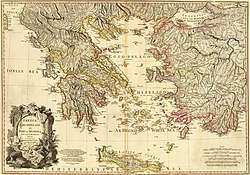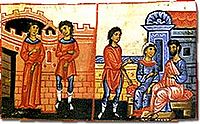Byzantine Greece
This article's lead section may be too short to adequately summarize the key points. (September 2019) |
| History of Greece |
|---|
 |
|
|
Byzantine Greece has a history that mainly coincides with that of the Byzantine Empire itself.
Background: Roman Greece

The
Greece was a typical eastern province of the
Life in Greece continued under the Roman Empire much the same as it had previously, and
During that period, Greek intellectuals such as
At the same time, Greece and much of the rest of the Roman east came under the influence of
Early years (4th century)


During the second and third centuries, Greece was divided into provinces including
Greece faced invasions from the Heruli, Goths, and Vandals during the reign of Theodosius I. Stilicho, who acted as regent for Arcadius, evacuated Thessaly when the Visigoths invaded in the late 4th century. Arcadius' Chamberlain Eutropius allowed Alaric to enter Greece, and he looted Corinth, and the Peloponnese. Stilicho eventually drove him out around 397 and Alaric was made magister militum in Illyricum. Eventually, Alaric and the Goths migrated to Italy, sacked Rome in 410, and built the Visigothic Empire in Iberia and southern France, which lasted until 711 with the advent of the Arabs.
Greece remained part of the relatively unified eastern half of the empire. Contrary to outdated visions of
Following the
Reorganization and external threats (5th–8th centuries)


Greece was raided in Macedonia in 479 and 482 by the Ostrogoths under their king, Theodoric the Great (493–526).[2] The Bulgars also raided Thrace and the rest of northern Greece in 540 and on repeated other occasions. These continuing Bulgar invasions required the Byzantine Empire to build a defensive wall, called the "Anastasian Wall," that extended for some thirty (30) miles, or more, from the city of Selymbria (now Silivri) to the Black Sea.[3] The Huns and Bulgars raided Greece in 559 until the Byzantine army returned from Italy, where Justinian I had been attempting to capture the heart of the Roman Empire.[4]
According to historical documents, the Slavs invaded and settled in parts of Greece beginning in 579 and Byzantium nearly lost control of the entire peninsula during the 580s.[5] However, there is no archaeological evidence indicating Slavic penetration of imperial Byzantine territories before the end of the 6th century. Overall, traces of Slavic culture in Greece are very rare.[6]


The city of
In 610, Heraclius became Emperor. During his reign, Greek became the official language of the empire.
During the early 7th century, Constans II made the first mass-expulsions of Slavs from the Greek peninsula to the Balkans and central Asia Minor. Justinian II defeated and destroyed most of the Sclaviniae, and moved as many as 100–200,000 Slavs from the Greek peninsula to Bithynia, while he enlisted some 30,000 Slavs in his army.[7]
The Slavic populations that were placed in these segregated communities were used for military campaigns against the enemies of the Byzantines. In the
In the mid-7th century, the empire was reorganized into "
These themes rebelled against the
Prosperity and Byzantine victories (8th–11th centuries)

In the late
By Basil's death in 1025, Greece was divided into themes including Crete, the
. They were protected from raids and invasions by the new themes created out of Bulgar territory.Greece became more prosperous in the 10th century and towns and cities began to grow again. Athens and Corinth probably grew to about 10,000 people, while Thessalonica may have had as many as 100,000 people. There was an important aristocratic class from these themes, especially the Macedonian emperors who ruled the empire from 867 to 1056.
Fourth Crusade and Latin conquest
Greece and the empire as a whole faced a new threat from the
also raided Thrace during this period.In 1147, while the knights of the Second Crusade made their way through Byzantine territory, Roger II of Sicily captured Corcyra and pillaged Thebes and Corinth.
In 1197,
Greece was relatively peaceful and prosperous in the 11th and 12th centuries, compared to Anatolia which was being overrun by the Seljuks. Thessalonica had probably grown to about 150,000 people, despite being looted by the Normans in 1185. Thebes also became a major city with perhaps 30,000 people, and was the centre of a major silk industry. Athens and Corinth probably still had around 10,000 people. Mainland Greek cities continued to export grain to the capital in order to make up for the land lost to the Seljuks.
However, after Constantinople was conquered during the Fourth Crusade in 1204, Greece was divided among the Crusaders. The
Byzantine reconquest and reestablishment

By the reign of
The Peloponnese, usually called
Ottoman threat and conquest
The Ottomans had begun their conquest of the Balkans and Greece in the late 14th century and early
Gallery
-
Kapnikareachurch, Athens
-
View of Hosios Loukas monastery, an example of Byzantine architecture during the Macedonian Renaissance
-
Mosaics of Nea Moni of Chios
-
Despotate of the Morea (1349–1460)
-
The Byzantine Castle of Angelokastro (Corfu) successfully repulsed the Ottomans
See also
- Byzantine Empire
- Byzantine Greeks
- Byzantine scholars in Renaissance
- Frankokratia
- Medieval Greece
References
- ^ a b c Rothaus, p. 10. "The question of the continuity of civic institutions and the nature of the polis in the late antique and early Byzantine world have become a vexed question, for a variety of reasons. Students of this subject continue to contend with scholars of earlier periods who adhere to a much-outdated vision of late antiquity as a decadent decline into impoverished fragmentation. The cities of late-antique Greece displayed a marked degree of continuity. Scenarios of barbarian destruction, civic decay, and manorialization simply do not fit. In fact, the city as an institution appears to have prospered in Greece during this period. It was not until the end of the 6th century (and maybe not even then) that the dissolution of the city became a problem in Greece. If the early sixth-century Synecdemus of Hierocles is taken at face value, late-antique Greece was highly urbanized and contained approximately eighty cities. This extreme prosperity is borne out by recent archaeological surveys in the Aegean. For late-antique Greece, a paradigm of prosperity and transformation is more accurate and useful than a paradigm of decline and fall."
- ^ John Julius Norwich, Byzantium: The Early Centuries (Alfred A. Knopf: New York, 1996)
- ^ John Julius Norwich, Byzantium: The Early Centuries, p. 187.
- ^ Robert S. Hoyt & Stanley Chodorow, Europe in the Middle Ages (Harcourt, Brace & Jovanovich, Inc.: New York, 1976) p. 76.
- ^ John Julius Norwich, Byzantium: the Early Centuries, p. 260.
- ^ "Slavs." Oxford Dictionary of Byzantium, Volume 3, pp. 1916-1919.
- ^ John Julius Norwich, Byzantium: The Early Centuries, p. 329.
- ISBN 0-521-81539-8
- ^ Niavis, Pavlos. The Reign of the Byzantine Emperor Nicephorus I. (AD 802-811). Cambridge University Press, 2006.
- ^ John Julius Norwich, Byzantium: The Early Years, pp. 330-331
- ^ Robert S. Hoyt & Stanley Chodorow, Europe in the Middle Ages
- ^ John Julius Norwich, Byzantium: The early Centuries, p. 342.
Bibliography
- Avramea, Anna (2012). Η Πελοπόννησος από τον 4ο ως τον 8ο αιώνα: Αλλαγές και συνέχεια [The Peloponnese from the 4th to the 8th century: Changes and continuity.] (in Greek). Athens: National Bank of Greece Cultural Foundation. ISBN 978-960-250-501-4.
- Bon, Antoine (1951). Le Péloponnèse byzantin jusqu'en 1204 (in French). Presses Universitaires de France.
- ISBN 978-0-521-81539-0.
- ISBN 978-0-7486-3809-3.
- ISBN 0-472-08149-7.
- ISBN 0-472-08260-4.
- ISBN 0-246-10559-3.
- ISBN 978-0-521-13089-9.
- Rothaus, Richard M. Corinth: The First City of Greece. Brill, 2000. ISBN 90-04-10372-4
- Dimov, G. The Notion of the Byzantine City in the Balkans and in Southern Italy - 11th and 12th Centuries - В: Realia Byzantino-Balcanica. Сборник в чест на 60 годишнината на професор Христо Матанов. София, 2014.











